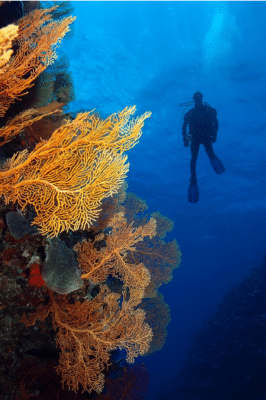The molecular ecophysiology of closely related pocilloporid corals of New Caledonia
(2017)
The molecular ecophysiology of closely related pocilloporid corals of New Caledonia
By, Anderson B. Mayfield, Chii-Shiarng Chen, Alexandra C. Dempsey
Abstract
 Given the severe threats against Earth’s coral reef ecosystems, there is an urgent need to collect baseline data such that the condition of these endangered habitats can be tracked over the coming decades. Many of the most spectacular coral reefs are found in remote locations that are only accessible by research ships; therefore, little is known about the vast majority of the planet’s reefs. In order to fill in a critical knowledge dearth in an ecologically important section of Melanesia, the Khaled bin Sultan’s Living Oceans Foundation carried out coral reef surveys in both the far southern and far northern regions of New Caledonia as part of their “Global Reef Expedition.” There was a particular emphasis on monitoring the health of the resident pocilloporid corals, which, like all reef-building scleractinians, are engaged in a mutualistic relationship with intracellular dinoflagellates of the genus Symbiodinium. Of the 120 Pocillopora spp. colonies analyzed in detail, 10 were found to be outliers based on a series of multivariate statistical approaches. These aberrantly behaving colonies differed from statistically normal ones in demonstrating higher expression levels of two host coral and four Symbiodinium mRNAs. Furthermore, all 10 colonies were found in the relatively more densely populated and mined south; no outliers were uncovered in the northern atolls, which encompass some of the most pristine and aesthetically appealing reef ecosystems in the world. That being said, mRNA expression of nearly all stress-sensitive biomarkers was higher in these New Caledonian corals than in closely related pocilloporids from other regions of the South Pacific. This suggests that even the remote reefs and atolls of the country’s far northern reaches have not been completely spared from anthropogenic harm.
Given the severe threats against Earth’s coral reef ecosystems, there is an urgent need to collect baseline data such that the condition of these endangered habitats can be tracked over the coming decades. Many of the most spectacular coral reefs are found in remote locations that are only accessible by research ships; therefore, little is known about the vast majority of the planet’s reefs. In order to fill in a critical knowledge dearth in an ecologically important section of Melanesia, the Khaled bin Sultan’s Living Oceans Foundation carried out coral reef surveys in both the far southern and far northern regions of New Caledonia as part of their “Global Reef Expedition.” There was a particular emphasis on monitoring the health of the resident pocilloporid corals, which, like all reef-building scleractinians, are engaged in a mutualistic relationship with intracellular dinoflagellates of the genus Symbiodinium. Of the 120 Pocillopora spp. colonies analyzed in detail, 10 were found to be outliers based on a series of multivariate statistical approaches. These aberrantly behaving colonies differed from statistically normal ones in demonstrating higher expression levels of two host coral and four Symbiodinium mRNAs. Furthermore, all 10 colonies were found in the relatively more densely populated and mined south; no outliers were uncovered in the northern atolls, which encompass some of the most pristine and aesthetically appealing reef ecosystems in the world. That being said, mRNA expression of nearly all stress-sensitive biomarkers was higher in these New Caledonian corals than in closely related pocilloporids from other regions of the South Pacific. This suggests that even the remote reefs and atolls of the country’s far northern reaches have not been completely spared from anthropogenic harm.